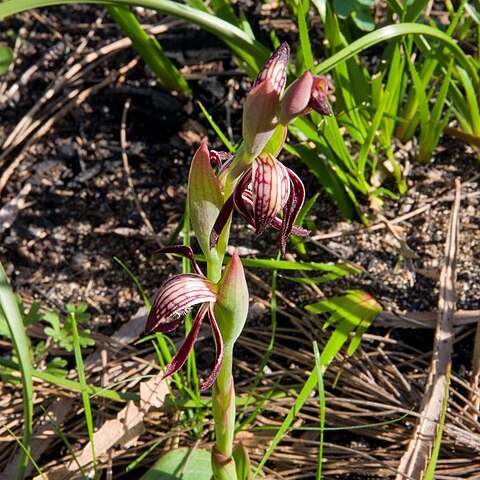Leaf single, broadly ovate to heart-shaped, ground-hugging, 25–130 × 40–80 mm, fleshy, bright green with pale veins, often with black marks. Flower stem 100–300 mm long, fleshy, with 2–3 loose, leafy stem bracts to 40 mm long, 1–8-flowered. Flowers nodding, 20–30 × 30–40 mm, white with red stripes and markings (rarely pink or yellow). Dorsal sepal ovate-lanceolate, 25–30 × 5–7 mm, hooding column. Lateral sepals linear, 25–30 × 2 mm, deflexed, divergent. Petals linear, 22–27 × 3 mm, spreading. Labellum 10–12 × 6–8 mm, curved, white with crimson lines; lateral lobes erect; midlobe short, deeply fringed, the fringes branched. Callus a narrow, tapered central plate with a few small, scattered sessile calli. Column incurved, 9–10 × 3.5–4 mm, a cluster of large papillae behind anther.
More
A ground orchid. It grows 10-20 cm high. It forms extensive colonies. The leaves are 6-9 cm long by 5-8 cm wide. They are broadly oval or heart shaped. They are fleshy and bright green. They can have black marks. They are close to the ground. The flower stem is 10-20 cm tall and fleshy. There are 2-8 flowers on a stalk. The flowers are 3-4 cm across and red and white. There are brown leathery bracts under the flowers.
Widespread and common from coast to inland areas; found growing in many habitats, including coastal scrub, heathland, heathy forest, open forest, woodland and mallee shrubland in freely draining to moisture-retentive sand and loam.
More
It is a temperate plant. Flowers grow after a summer fire. It grows in a range of habitats.

